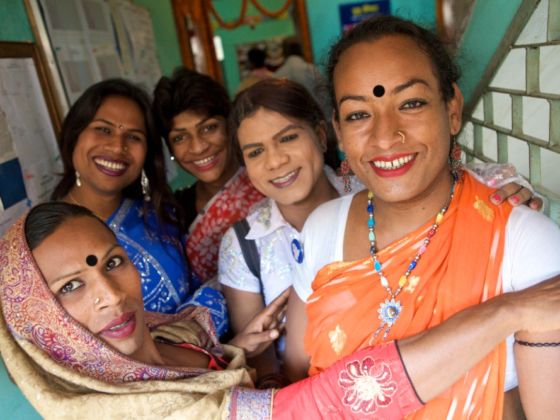INDIA and other countries in the Indian subcontinent, including Nepal, Bangladesh and Pakistan, are at the forefront of an acceptance and empowerment movement for transgender individuals. Gender diversity is deeply rooted in India. One of the most significant Hindu deities, Shiva, has the ability to transform genders on a whim when he merges with his wife, Parvati to become the androgynous deity Ardhanarishvara. In ancient Hindu texts, such as Mahabharata and Ramayana, those who have gender ambiguity are seen as demi-gods and are celebrated for being between genders. In Manusmriti, a Hindu rule book, a passage reads, “a male child is produced by a greater quantity of male seed, a female child by the prevalence of the female; if both are equal, a third-sex child or boy-and-girl twins are produced.” The Kama Sutra, written in India around 300 BC, includes a wide spectrum of genders partaking in sexual acts.


Here's What the World Could Learn From India's Third Gender Acceptance
Hijra, the male-to-female trans community in the Indian subcontinent goes back 4,000 years. Historically, Hijras have bestowed blessings of good fortune and fertility onto homes and families by making special appearances at occasions like housewarmings, births, and marriages. Their mystical powers are believed to come from their ability to live between the sexes.
Despite the historical importance of transgender individuals in India, these people were denied basic rights, the ability to vote, medical care, education, fair employment opportunities, and were often forced into poverty in their own country. They were ostracized by their communities for self-determining their gender.
The first step towards third gender equality occurred in India in 2009 when the Election Commission added “other” as a gender option on official ballots. The Supreme Court in India has recognized Hijras and other transgender groups as an official third gender in a 2014 landmark ruling. In the 2011 Indian Census, nearly half a million transgender people registered under the ‘other’ gender option. It is estimated that today over 2 million Indians identify with a non-binary gender.
A nationwide awareness and acceptance campaign was launched as the first step in erasing the deeply-rooted social stigma and prejudices that this vulnerable group faces from other members of society. The campaign was managed by the newly-implemented government social welfare programs that had been created to support the third gender community.
It is now a crime in India to discriminate against any person who has surgically changed their sex. A quota of employment and education opportunities must be given to those in the third gender society just like other recognized minority groups. Local governments in India are now required to create accessible public bathrooms to ensure the safety and comfort of third gender Indians who may use the facility of their choice; thus India is setting a humane standard for the rest of the world to follow.
The fight for legal acceptance and respect of third genders in India was led by the many activists who risked their lives and reputations by demanding recognition by policy makers and took the case all the way to the Supreme Court. Since the groundbreaking ruling, members of the third genders community have taken political office and other prominent roles in India. In 2015, Madhu Bai Kinnar became the first openly transgender mayor in India. The same year, Dr. Manabi Bandopadhyay became the first transgender college principal. In 2016, Padmini Prakash became India’s first transgender news anchor on the daily prime-time news program Lotus TV. India now has a transgender pastor, banker, police inspector, taxi service and modeling agency, bringing global visibility to a formerly marginalized community.
In the Indian state of Kerala, the nation’s first transgender residential school was recently opened. Sahaj International will offer courses in development to transsexual students. A transgender wedding was held in a temple in Mumbai — Madhuri Sarode, a transgender, married Jay Kumar Sharma in a traditional Hindu ceremony. Theirs was not the first transgender marriage in India, but it is considered to be the first legal joining that was not facilitated in secret. While the marriage should technically be legally accepted as Madhuri has legal third gender status, it will be a complicated process for the couple to receive their marriage certificate.
The world is far behind in providing the transgender population with legal recognition and equal rights. Indian Supreme Court Justice KS Radhakrishnan said, “recognition of transgenders as a third gender is not a social or medical issue but a human rights issue.” We are seeing an escalating global demand to update policies to provide transgender people fundamental human rights and basic civil liberties.
A handful of countries has passed legislation that provides acknowledgement for third gender people by simply creating the option to select a non-binary gender option on official forms. TransRespect.org has created a global map tracking the legality of gender change in countries and territories around the world. It is time for the rest of the world to follow India’s steps and adopt policies that adhere to gender as a social construct and allow individuals to define their own gender.
Note: Third gender refers to a person who does not self-identify with their biological sex. This includes cisgender and transgender individuals, intersex people with a personal identity that is not exclusively female or male, agender individuals without a gender, gender-fluid individuals whose gender identity changes, pangender people who have traits from all genders and more. For a further understanding please refer to the Human Rights Campaign resource on the trans community.